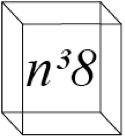I was listening to the Apollo 11 logs sampled in the Austere composition "Principium Somniferum", recorded when the spacecraft departed Earth's gravitational field to be captured by the Moon's. It's a profound composition inspired by the similarly profound story of men sling-shotting themselves in a bubble of metal away from the protection of Earth's physics toward a desolate chunk of rock based on an extreme faith in their mathematical calculations and belief that they'd packed adequate provisions for the journey.
The transitional moment the Houston engineer spoke of reminded me of a concept my father often pondered and discussed. Humans, being bipeds who evolved with their brains accustomed to living at walking or running speeds, have to adapt their thinking to the discontinuity of the way we travel today. Our minds have a timeline of prediction that leads minutes, hours, days ahead of where we are at the present time. When we make large leaps like from SFO to NYC, he says there is a point before we get to our airplane that our minds make the leap ahead of us. For those moments after the mental leap, our bodies walk in old-space while our minds operate and plan in new-space. We become spatially-spread zombies with head in one place and body in another. (This may be why it's so disorienting to have our flights cancelled. As it's virtual decapitation.)
These thoughts in turn make me think of how long it will take for our technology to catch up with our travel-bound heads. Our location based services (LBS) are great at tracking the trail we've left behind. They help us savor our last meal with lovingly posed spreads on Yelp, they help us scan the crowd at a venue we visit to see if the digital presence of our kin can be sniffed through the crowds on Foursquare/Gowalla. The first pioneers of the space are using the mechanics of group interaction to capture shared intentions. (Ditto, Plancast and Tripit see that social momentum of friendship can result in shared plans that otherwise might be solitary if not communicated.)
The way we engage with the world through social interactions is perhaps the easiest way through current technology to make predictions about the future. For example, we can tell if a 415 area code starts communicating intensely with 212's, more than all local interactions, that this phone's owner in travel-zombie state. Tools like Waze crowdsourced maps can measure velocity to make aggregate predictions about the status of the location they are moving through and even of the phone owner themselves.
We are soon to see a future-scope tool, perhaps first in mobile app form, that will help us make the "teleporting" leap from where we are to where we intend to be. Perhaps we can flag to those around us a status message of "I'm not really here" so they behave courteously to our zombie bodies as the shift in reference is made to our new place of being. Perhaps those in our new location will be able to sense our presence. Our disembodied head of intent will manifest its presence before our physical body has to show up. Our travel limbo will always be disorienting until body and mind can move at the same speeds. Right now technology we experience is footprint-centric instead of intention centric.
As we slingshot ourselves about in our metal bubbles with extreme faith, half present where we are, perhaps technology will help us be the slightest bit more aware. Often, in travel, we could not be more absent.
For downloads of Austere's Principium Somniferum visit:
http://www.cdbaby.com/cd/freqmagnet
For Austere discography visit: http://www.discogs.com/artist/Austere
Quoted from Apollo 11 Mission logs:
"This is Apollo Control at 61 hours, 39 minutes. We've had no further conversation with the crew since our last report. Flight Surgeon says there is no indication at this time that they have begun to sleep, but we expect they'll be getting to sleep here shortly. Coming up in less than 10 seconds now, we'll be crossing into the sphere of influence of the Moon. A computational changeover will be made here in Mission Control at this point, as the Moon's gravitational force becomes the dominant effect on the spacecraft trajectory, and our displays will shift from Earth-reference to Moon-reference. At that point, which occurred a few seconds ago, the spacecraft was at a distance of 186,437 nautical miles [] from Earth, and 33,822 nautical miles [] from the Moon. The velocity with respect to the Earth was 2,990 feet per second [], and with respect to the Moon, about 3,272 feet per second []. The Passive Thermal Control mode that was set up for the second time by the crew appears to be holding well at this point, and all spacecraft systems are functioning normally. Mission going very smoothly. At 61 hours, 41 minutes; this is Apollo Control, Houston. "
Source: http://history.nasa.gov/ap11fj/10day3-flight-plan-update.htm

